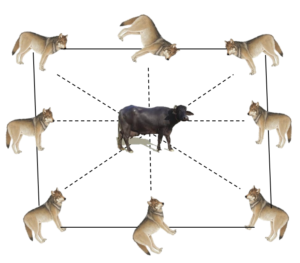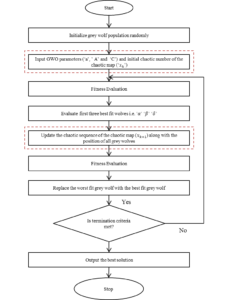Dissertation Algorithm Development Tips For Developing Grey Wolf Optimization Algorithm Where And How It Is Solve Combined Economic Emission Dispatch Problems?
Dissertation Algorithm Development Ideas From Existing Recent Research Gaps In Computer Science Engineering Domain
In Brief
• You will find the best dissertation research areas / topics for future researchers enrolled in Engineering and technology
• In order to identify the future research topics, we have reviewed the Engineering literature (recent peer-reviewed studies) on the AI in optimization problems
• Nature-Inspired Optimization Algorithm is the recent trend in Artificial Intelligence.
• Grey Wolf Optimizer (GWO) is one of Nature-Inspired Optimization Algorithm.
• Grey Wolf Optimizer (GWO) is inspired by grey wolves called Canis lupus
• Grey Wolf Optimizer is used to solve complicated aircraft problems like weapon target assignment problem (WTA) and also used to solve combined economic emission dispatch problems
Over the couple of decades, meta-heuristic optimization strategies have become very prevalent, particularly in engineering applications (Jaafari et al., 2019). Some of the common reason is that they are easy to implement, they are simple in concept, the gradient data is not necessary, local optima can circumvent them, they can be used in a wide variety of disciplinary issues (Abdel-Basset, El-Shahat, El-henawy, de Albuquerque, & Mirjalili, 2020). Grey wolf optimization is one of the popular meta-heuristic optimization algorithms discussed in this blog.
The Grey wolf (Canis lupus) Behaviour
Grey wolf (Canis lupus) is a member of the Canidae. Grey wolves are regarded as predators of the apex, indicating that they are at the top of the pyramid (food chain). Most of the grey wolves love to live in a group. The average group size is 5–12. The interesting fact about the grey lifestyle is that the grey wolf has a very strict social dominance hierarchy, as shown in figure 1.

Figure 1 Hierarchy of grey wolf
Source Adopted From: Mirjalili, Seyedali, Mirjalili, and Lewis (2014)
PhD Assistance develop ML algorithms using Python, Hadoop framework and many more to both secure access control in Networking platforms. Hiring our experts, you are assured with quality and on-time delivery.
The hierarchy consists of alpha, beta, omega and delta. The grey wolf’s first level is Alpha and they are group leaders. Alphas can be male and female and they are the decision-makers. The alpha is multitasking in nature. It predominantly smart enough to decide all the wolf’s hunting, sleeping, wake-up time, etc. The decisions made by the alpha are communicated to the pack. Further there is also some kind of democratic behaviours. Some kind of cooperative activity was also found, however, in which the other wolves in the pack have to obey an alpha. The whole pack honours the alpha in meetings by holding down their tails. The alpha wolf is also known as the dominant wolf, as the pack must obey his / her orders (Mech, 1999). Alpha wolves are only permitted to mate in the pack. It is interesting to note that the alpha is not always the pack’s strongest member, but it is the best leader in pack managing. This reveals that a pack’s organization and discipline is more important than its strength (Gupta & Deep, 2019).
In the hierarchy of grey wolves, the second level is Beta. The betas are auxiliary wolves who support the alpha in taking decisions or any other packaging tasks. The beta wolf could be female or male, and if in case one of the alpha wolves becomes very old or passes away, he/she is possibly the best choice to be the alpha. The beta wolf is supposed to honour the alpha, but can also order the other lower-level wolves. It takes on the role of alpha assistant and pack supervisory. The beta confirms the alpha orders throughout the pack and provides input to the alpha.
Hire PhD Assistance experts to develop your algorithm and coding implementation for your Computer Science dissertation Services.
The lowest grey wolf ranking is Omega. The omega takes a scapegoat’s role. All other dominant wolves can comment on the omega wolves. The Omega wolf is allowed to eat at last. It might seem that the omega is not an essential animal in the pack, but it has been noted that in scenario of losing the omega, the entire pack will face the internal fight and few more issues. This is because the omega(s) brings down aggression and anger of all wolves. It helps to please the whole pack and preserve the system of dominance. The omega is also the nannies (babysitters) in the family in certain situations (Saxena, Kumar, & Das, 2019).
If a wolf is not an alpha, beta, or omega, in some sources he/she is named as Delta. The delta wolves must report to alphas and betas. However, they can rule the omega. Sentinels, Scouts, caretakers, hunters and elders are in this group. Scouts are accountable for controlling territorial borders and alerting the pack in the event of any hazard. Sentinels ensure the pack’s security and guarantee. Elders are the old skilled alpha or beta wolves. Hunters assist the alphas and betas during prey hunting and supplying the pack with food. Eventually, the caretakers take good care of the poor, sick and injured wolves in the pack. Another interesting behaviour of grey wolves is group hunting. The predominant stages of grey wolf hunting are tracking, chasing, and reaching the prey (Muro, Escobedo, Spector, & Coppinger, 2011) The victim will be hunted, encircled and threatened until it stops moving. Fig 2 represents the grey wolf attack process towards the prey.

Figure 2 The grey wolf attack towards the prey
Soure Adopted From: Niu, Niu, Liu, and Chang, (2019)
PhD Assistance experts has experience in handling dissertation and assignment in computer science research with assured 2:1 distinction. Talk to Experts Now
Grey Wolf Optimizer Algorithm
The hunting strategy and the social hierarchy of grey wolves were mathematically modelled and developed as a Grey Wolf optimizer algorithm. Fig 3 illustrates the grey wolf algorithm flowchart.

Figure 3 Grey wolf Algorithm
Source Adpoted From: Kohli and Arora,(2018)
The working process of the Grey Wolf Optimizer Algorithm is given below,
1. The grey wolf population is initiated randomly 𝑋𝑖 (i=1, 2,…, n)
2. Randomly mapping the chaotic map 𝑥0
3. Then fitness will be evaluated
4. The first three fitness will be alpha, beta and omega (𝛼,𝛽,𝛿)
• 𝑋𝛼 = The best wolf
• 𝑋𝛽 = The second best wolf
• 𝑋𝛿 =The third-best wolf
5. According to fitness, the population of grey wolf is sorted.
6. For each search agent, the chaotic number is updated using a chaotic map equation
7. Now the new position is updated depending on the fitness of wolf
8. The best wolf replace the worst wolf (the Best solution is obtained).
Conclusion:
The hunting strategy and the social hierarchy of grey wolves have been mathematically modelled and developed as an algorithm for Grey Wolf Optimiser (GWO). It is efficient and powerful algorithm to solve problems of continuous optimization as well as real-life optimization. The GWO is able to solve complex engineering problems with high efficiency and superior performance. It is used in aircraft engineering to overcome weapon target assignment problems and also used to solve combined economic emission dispatch problems.
PhD Assistance has vast experience in developing dissertation research topics for students pursuing the UK dissertation in computer science. Order Now
Future scope
1. Can be used in optimal positioning and sizing multiple active power filters in the radial distribution system (Lakum & Mahajan, 2019).
2. Can be used as a bridging tool (Saxena et al., 2019)
3. Can be used as an adaptive neuro-fuzzy inference system (Jaafari et al., 2019)
Referred Blog
References
-
- Abdel-Basset, M., El-Shahat, D., El-henawy, I., de Albuquerque, V. H. C., & Mirjalili, S. (2020). A new fusion of grey wolf optimizer algorithm with a two-phase mutation for feature selection. Expert Systems with Applications, 139, 112824.
- Gupta, S., & Deep, K. (2019). A novel Random Walk Grey Wolf Optimizer. Swarm and Evolutionary Computation, 44, 101–112
- Jaafari, A., Panahi, M., Pham, B. T., Shahabi, H., Bui, D. T., Rezaie, F., & Lee, S. (2019). Meta optimization of an adaptive neuro-fuzzy inference system with grey wolf optimizer and biogeography-based optimization algorithms for spatial prediction of landslide susceptibility. CATENA, 175, 430–445.
- Kohli, M., & Arora, S. (2018). Chaotic grey wolf optimization algorithm for constrained optimization problems. Journal of Computational Design and Engineering, 5(4), 458–472.
- https://doi.org/10.1016/j.jcde.2017.02.005
Lakum, A., & Mahajan, V. (2019). Optimal placement and sizing of multiple active power filters in radial distribution system using grey wolf optimizer in presence of nonlinear distributed generation. Electric Power Systems Research, 173, 281–290. - Mech, L. D. (1999). Alpha status, dominance, and division of labor in wolf packs. Canadian Journal of Zoology, 77(8), 1196–1203
- Mirjalili, Seyedali, Mirjalili, S. M., & Lewis, A. (2014). Grey Wolf Optimizer. Advances in Engineering Software, 69, 46–61.
- Muro, C., Escobedo, R., Spector, L., & Coppinger, R. P. (2011). Wolf-pack (Canis lupus) hunting strategies emerge from simple rules in computational simulations. Behavioural Processes, 88(3), 192–197
- Niu, P., Niu, S., Liu, N., & Chang, L. (2019). The defect of the Grey Wolf optimization algorithm and its verification method. Knowledge-Based Systems, 171, 37–43.
- Saxena, A., Kumar, R., & Das, S. (2019).
β-Chaotic map enabled Grey Wolf Optimizer. Applied Soft Computing, 75, 84–105
 Previous Post
Previous Post Next Post
Next Post
